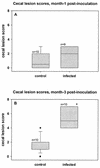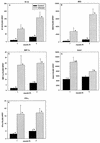Analysis of gene expression in ceca of Helicobacter hepaticus-infected A/JCr mice before and after development of typhlitis
- PMID: 12819073
- PMCID: PMC162032
- DOI: 10.1128/IAI.71.7.3885-3893.2003
Analysis of gene expression in ceca of Helicobacter hepaticus-infected A/JCr mice before and after development of typhlitis
Abstract
The inflammatory bowel diseases, Crohn's disease and ulcerative colitis, are chronic inflammatory disorders of the gastrointestinal tract. The causes of these diseases remain unknown; however, prevailing theories suggest that chronic intestinal inflammation results from a dysregulated immune response to ubiquitous bacterial antigens. While a substantial body of data has been amassed describing the role of the adaptive immune system in perpetuating and sustaining inflammation, very little is known about the early signals, prior to the development of inflammation, that initiate and direct the abnormal immune response. To this end, we characterized the gene expression profile of A/JCr mice with Helicobacter hepaticus-induced typhlitis at month 1 of infection, prior to the onset of histologic disease, and month 3 of infection, after chronic inflammation is fully established. Analysis of the gene expression in ceca of H. hepaticus infected mice revealed 25 up-regulated and 3 down-regulated genes in the month-1 postinoculation group and 31 up-regulated and 2 down-regulated genes in the month-3 postinoculation group. Among these was a subset of immune-related genes, including interferon-inducible protein 10, monokine induced by gamma interferon, macrophage-induced protein 1 alpha, and serum amyloid A1. Semiquantitative real-time reverse transcriptase PCR confirmed the increased expression levels of these genes, as well as elevated expression of gamma interferon. To our knowledge, this is the first report profiling cecal gene expression in H. hepaticus-infected A/JCr mice. The findings of altered gene expression prior to the development of any features of pathology and the ensuing chronic disease course make this an attractive model for studying early host response to microbe-induced inflammatory bowel disease.
Figures



Similar articles
-
Sex influence on chronic intestinal inflammation in Helicobacter hepaticus-infected A/JCr mice.Comp Med. 2004 Jun;54(3):301-8. Comp Med. 2004. PMID: 15253277
-
Characterization of cecal gene expression in a differentially susceptible mouse model of bacterial-induced inflammatory bowel disease.Inflamm Bowel Dis. 2007 Jul;13(7):822-36. doi: 10.1002/ibd.20138. Inflamm Bowel Dis. 2007. PMID: 17455200
-
Pathogenicity of Helicobacter rodentium in A/JCr and SCID mice.Comp Med. 2004 Oct;54(5):549-57. Comp Med. 2004. PMID: 15575369
-
Helicobacter hepaticus infection in mice: models for understanding lower bowel inflammation and cancer.Mucosal Immunol. 2011 Jan;4(1):22-30. doi: 10.1038/mi.2010.61. Epub 2010 Oct 13. Mucosal Immunol. 2011. PMID: 20944559 Free PMC article. Review.
-
Immune mechanisms in the pathogenesis of inflammatory gastrointestinal disorders.Ital J Gastroenterol. 1996 Nov;28 Suppl 2:11-7. Ital J Gastroenterol. 1996. PMID: 14502788 Review.
Cited by
-
Gene expression analysis of toll like receptor 2 and 4, Dectin-1, Osteopontin and inflammatory cytokines in human dental pulp ex-vivo.BMC Oral Health. 2022 Dec 3;22(1):563. doi: 10.1186/s12903-022-02621-4. BMC Oral Health. 2022. PMID: 36463168 Free PMC article.
-
Quantitative trait loci in a bacterially induced model of inflammatory bowel disease.Mamm Genome. 2011 Oct;22(9-10):544-55. doi: 10.1007/s00335-011-9343-5. Epub 2011 Jun 30. Mamm Genome. 2011. PMID: 21717222 Free PMC article.
-
Expression of Toll-like receptor 2, Dectin-1, and Osteopontin in murine model of pulpitis.Clin Oral Investig. 2023 Mar;27(3):1177-1192. doi: 10.1007/s00784-022-04732-2. Epub 2022 Oct 7. Clin Oral Investig. 2023. PMID: 36205788
-
Evaluation of a commercial colorimetric fecal dipstick assay for the detection of Helicobacter hepaticus infections in laboratory mice.J Am Assoc Lab Anim Sci. 2010 May;49(3):312-5. J Am Assoc Lab Anim Sci. 2010. PMID: 20587162 Free PMC article.
-
Microbial considerations in genetically engineered mouse research.ILAR J. 2006;47(2):141-55. doi: 10.1093/ilar.47.2.141. ILAR J. 2006. PMID: 16547371 Free PMC article. Review.
References
-
- Akagi, S., E. Hiyama, Y. Imamura, Y. Takesue, Y. Matsuura, and T. Yokoyama. 2000. Interleukin-10 expression in intestine of Crohn disease. Int. J. Mol. Med. 5:389-395. - PubMed
-
- Bernstein, C., J. Blanchard, P. Rawsthorne, and A. Wajda. 1999. Epidemiology of Crohn's disease and ulcerative colitis in a central Canadian province: a population-based study. Am. J. Epidemiol. 149:916-924. - PubMed
-
- Boorsma, D. M., P. J. van Beek, C. Nieboer, T. J. Stoof, R. Willemze, C. P. Tensen, and T. L. Sorensen. 2001. Expression of specific chemokines and chemokine receptors in the central nervous system of multiple sclerosis patients. J. Pathol. 194:398-405. - PubMed
-
- Cao, Z. A., B. B. Moore, D. Quezada, C. H. Chang, and P. P. Jones. 2000. Identification of an IFN-gamma responsive region in an intron of the invariant chain gene. Eur. J. Immunol. 30:2604-2611. - PubMed
-
- Collazo, C. M., G. S. Yap, G. D. Sempowski, K. C. Lusby, L. Tessarollo, G. F. Woude, A. Sher, and G. A. Taylor. 2001. Inactivation of LRG-47 and IRG-47 reveals a family of interferon gamma-inducible genes with essential, pathogen-specific roles in resistance to infection. J. Exp. Med. 194:181-188. - PMC - PubMed
Publication types
MeSH terms
Substances
Grants and funding
LinkOut - more resources
Full Text Sources
Medical
Research Materials

